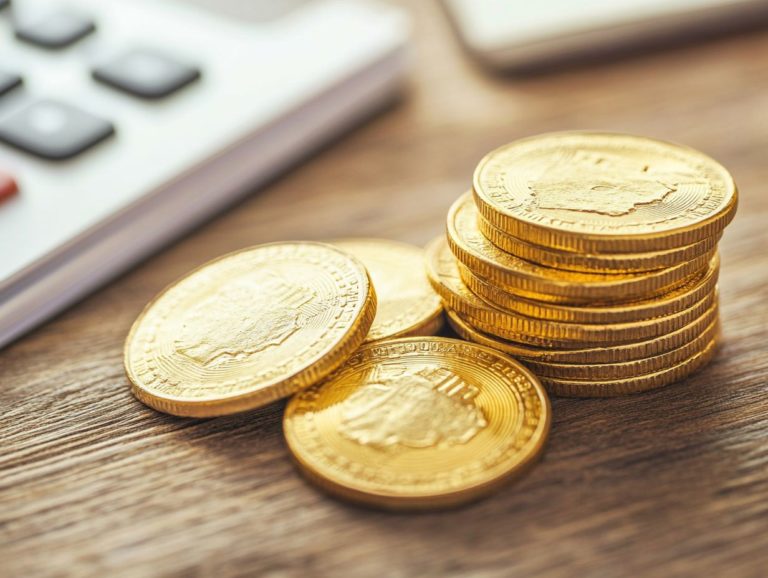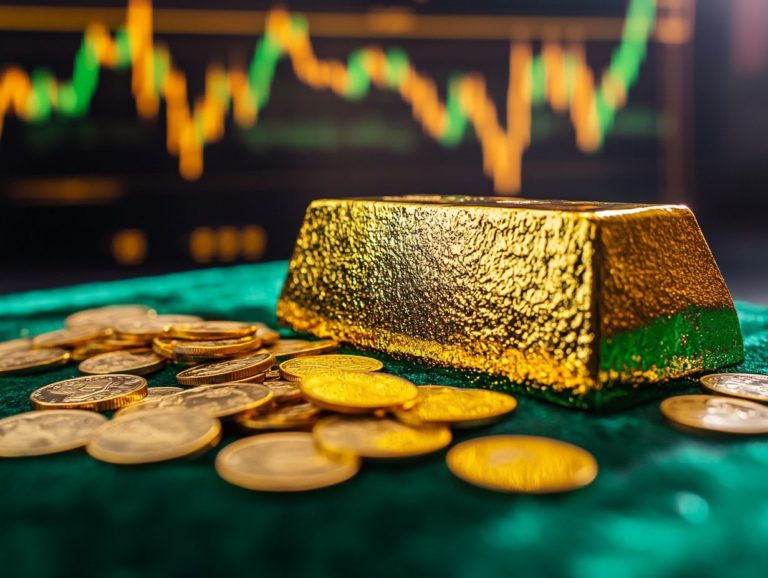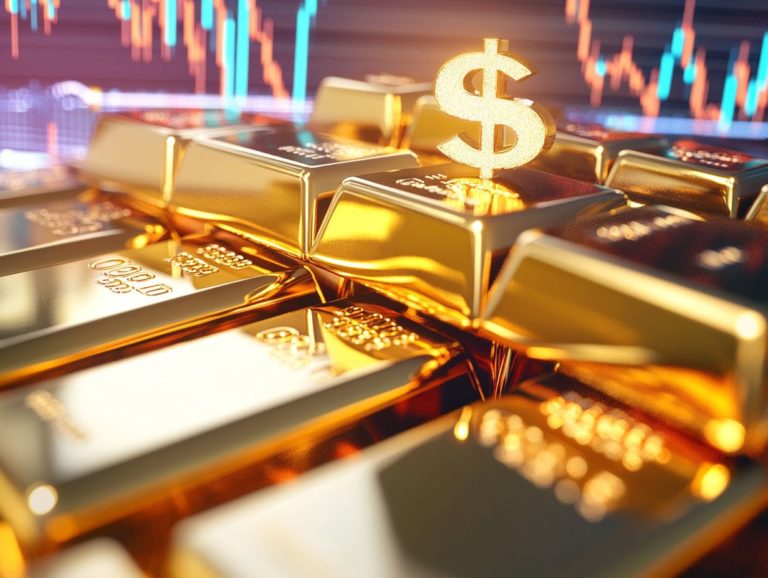5 Facts About Gold’s Role in Global Economy
Gold has been a big deal throughout history, serving not only as a symbol of wealth but also as a foundational element of economic systems.
From its role as currency for millennia to its pivotal place in the gold standard (a system where currency value is directly linked to gold), gold continues to exert influence over the global economy in myriad ways.
Let s explore five key facts about gold’s enduring impact, emphasizing its function as a hedge against inflation, its significance to central banks, and its critical role in international trade.
What does this mean for the economy today? Discover how gold shapes economic landscapes and what its implications are for countries around the world.
Contents
- Key Takeaways:
- 1. Gold Has Been Used as Currency for Thousands of Years
- 2. The Gold Standard Was Once the Basis of Global Economy
- 3. Gold Is Still Used as a Hedge Against Inflation
- 4. Central Banks Hold Large Reserves of Gold
- 5. Gold Plays a Role in International Trade
- What Is the Current Role of Gold in the Global Economy?
- What Are the Potential Risks of Using Gold as a Currency?
- How Has the Role of Gold in the Global Economy Changed Over Time?
- What Are the Factors That Affect the Price of Gold in the Global Market?
- What Are the Advantages and Disadvantages of Using Gold as a Standard for Currency?
- How Does the Use of Gold in the Global Economy Impact Different Countries?
- Frequently Asked Questions
Key Takeaways:

- Gold has a long history as a currency and has been used as a form of payment for thousands of years.
- The gold standard was once the foundation of the global economy, but it has since been replaced by fiat currency systems.
- Gold is still a popular hedge against inflation and is considered a safe investment option during economic downturns.
1. Gold Has Been Used as Currency for Thousands of Years
Gold boasts an illustrious history as a currency that stretches back thousands of years. It acted as a reliable medium of exchange that transcends cultures and civilizations, often representing wealth and stability.
Imagine the ancient Egyptians, who adorned their pharaohs with exquisite gold jewelry. Consider the pivotal role gold played in establishing the gold standard. This precious metal has consistently upheld its position as a vital element in both local and global economies, particularly during times of inflation and market volatility.
Various civilizations, such as the Lydians who minted some of the first coins in the 7th century BC, recognized gold s intrinsic value. Over the centuries, empires like the Romans and the Incas capitalized on its allure to foster trade and prosperity.
The gold standard, adopted in the 19th century, allowed currencies to be directly tied to gold, making international trade smoother and providing governments with a measure of accountability. When this standard was abandoned in the 20th century, it opened the door to more flexible monetary policies.
Even today, central banks also keep significant gold reserves, wielding it as a strategic asset to hedge against inflation and currency fluctuations. This ensures economic stability during uncertain times, allowing them to navigate the complexities of modern finance with confidence.
2. The Gold Standard Was Once the Basis of Global Economy
The gold standard has historically served as the backbone of the global economy. Currencies were directly tied to a specific amount of gold, providing a sense of stability and predictability in trade and investment.
This system was particularly crucial until the Bretton Woods Agreement reshaped the monetary landscape in the aftermath of World War II. It underscored how backing currencies with gold could inspire confidence, especially during times of inflationary pressures.
By anchoring currency values to a tangible asset, nations could cultivate trust among traders and investors. This facilitated smoother international transactions and minimized the risks associated with currency fluctuations.
While the gold standard offered a robust framework for economic stability, it also came with its own set of challenges. These included limited monetary flexibility and the risk of economic turmoil during gold shortages.
As global economies changed over time and the complexities of international finance deepened, a shift to fiat currencies became not just necessary but inevitable. This transition enabled governments to take greater control over their monetary policies, allowing them to tailor their economic strategies to address emerging challenges without the constraints of maintaining gold reserves.
3. Gold Is Still Used as a Hedge Against Inflation
In today’s unpredictable economic landscape, gold remains a powerful ally against inflation. It holds its allure for investors like you who want to shield their portfolios from the corrosive impact of rising consumer prices. As the dollar’s value diminishes, gold often finds its intrinsic worth appreciating. This makes it a vital part of any strategy to manage financial risks.
Consider the inflationary waves of the 1970s. During that time, gold prices soared as inflation rates hit their peak, showcasing its reliability as a store of value. Unlike other assets that tend to depreciate when inflation rises, gold has consistently provided a safe haven.
By integrating gold into your diversified investment portfolio, you can help mitigate the risks tied to market fluctuations.
Treasury Inflation-Protected Securities (TIPS), which are government securities designed to protect against inflation, offer a fixed interest return adjusted for inflation. However, they might not deliver the same potential gains as gold, especially in extreme scenarios where market conditions change rapidly.
4. Central Banks Hold Large Reserves of Gold
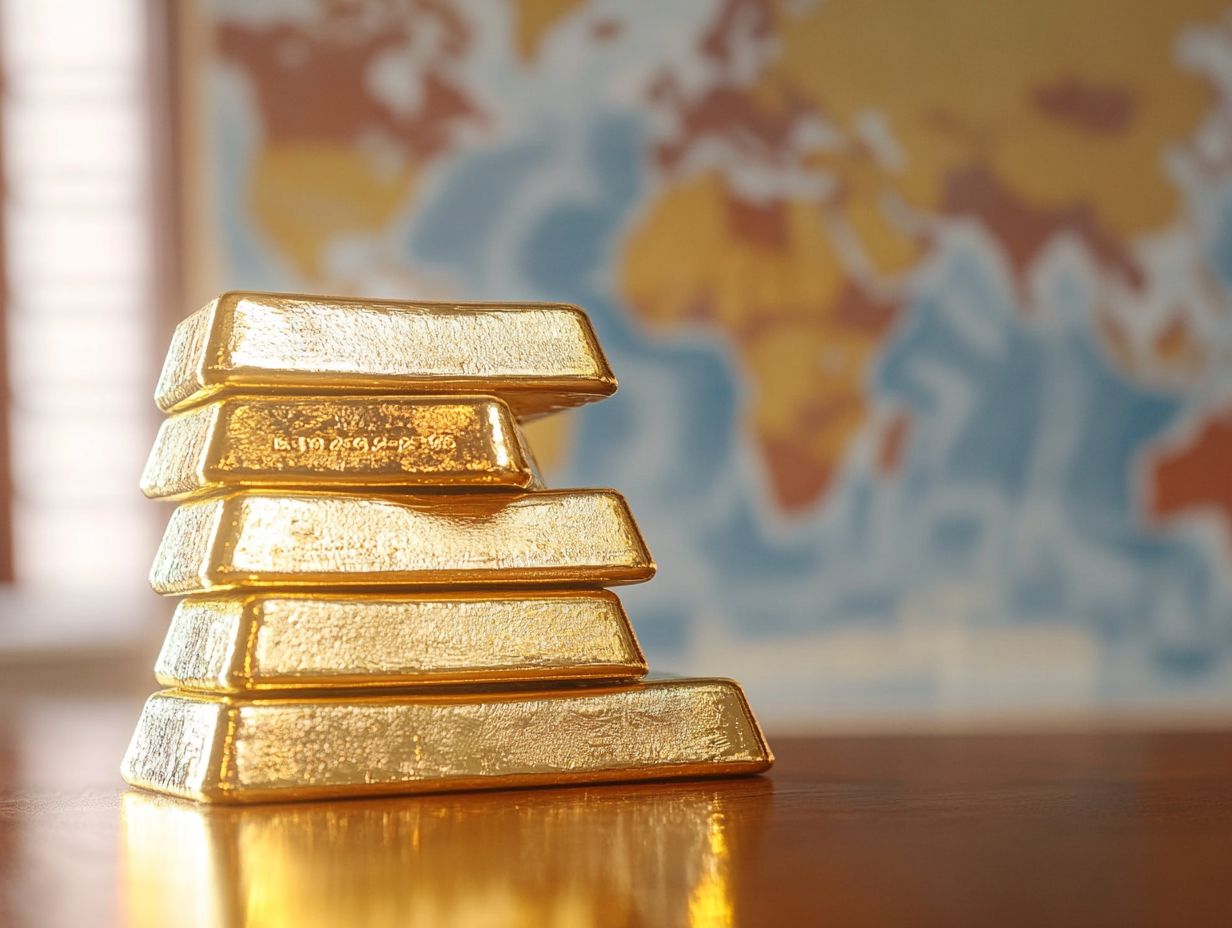
Throughout modern history, central banks have strategically accumulated substantial reserves of gold. This shows just how much trust these institutions place in gold as a safeguard during economic turbulence and a stabilizing asset in their monetary policy. It reflects their confidence in gold as a long-term investment, particularly in times of inflation and shifting market dynamics.
For example, current reports indicate that the United States boasts the largest gold reserves in the world, estimated at around 261 million troy ounces. Following closely are Germany with approximately 3,362 tonnes and China, which is steadily increasing its holdings to over 2,000 tonnes.
These immense reserves not only highlight the influential role central banks hold in the gold market but also impact global gold prices. This shapes investments and trade across nations. Enhanced policies from central banks regarding gold can send ripples through financial markets, prompting you to adjust your portfolio and hedge against potential downturns.
5. Gold Plays a Role in International Trade
Gold’s significance in international trade goes well beyond being a mere commodity. It acts as a universal currency that can effortlessly facilitate transactions across borders, embodying both economic strength and stability in the ever-shifting landscape of market dynamics. When countries engage in trade, gold frequently emerges as the preferred medium of exchange, particularly during times of geopolitical tension and economic uncertainty.
Gold also serves as a useful tool for transactions; it plays a crucial role in trade balances, enabling nations to manage their economic strategies with finesse. As a reserve asset, it provides a safeguard against inflation and currency devaluation, making it an essential element in international financial policies.
Fluctuations in gold prices can have a profound impact on global trade flows. This prompts countries to recalibrate their economic strategies accordingly. For example, nations might bolster their gold reserves to enhance confidence in their currencies or strive to secure advantageous trade agreements that leverage gold as collateral. By strategically leveraging gold, countries can forge powerful economic relationships that stand the test of time.
What Is the Current Role of Gold in the Global Economy?
Gold continues to hold an important role in the global economy, not just as a symbol of wealth but as a versatile investment vehicle. Both institutions and individuals often turn to gold during times of economic uncertainty. Its remarkable resilience against inflation and market volatility underscores its enduring appeal. This makes gold a valuable means of diversifying portfolios and mitigating risk.
You have the option to invest in physical gold, such as coins and bars, which provide tangible assets. Alternatively, you can choose gold exchange-traded funds (ETFs), a type of investment that allows you to buy shares in a collection of assets like gold, for a more liquid strategy. Mining stocks present an intriguing avenue, allowing you to capitalize on the operational successes of gold-producing companies. Furthermore, central banks significantly influence gold’s market value through their buying and selling strategies, shaping the dynamics of demand and supply.
This often leads investors to view gold as a safe haven during financial turmoil, enhancing its reputation as a reliable store of value amidst global economic fluctuations.
What Are the Potential Risks of Using Gold as a Currency?
While gold has long been celebrated as a reliable currency, it s essential to recognize that it comes with its own set of risks. These challenges can impact its liquidity and price stability, especially in today s economy marked by inflation and market volatility. Understanding how external factors like economic policies and global demand influence gold s role as a currency is key.
Historically, there have been significant moments that have questioned gold’s primacy as a currency. For instance, during the Great Depression, its rigid value stifled economic flexibility. Additionally, fluctuations in mining outputs and technological advancements can cause unpredictable price swings, posing challenges for anyone who relies on gold for transactions.
In contemporary discussions, these issues are under increasing scrutiny. Many are exploring alternative currencies, raising questions about gold’s effectiveness as a medium of exchange or a store of value in today s dynamic market landscape.
How Has the Role of Gold in the Global Economy Changed Over Time?

The role of gold in the global economy has experienced remarkable transformations. It has evolved from a universally accepted currency of ancient times into a diverse asset class that includes bullion, ETFs, and mining stocks. Each phase of this evolution has been influenced by inflationary pressures, technological advancements, and shifting economic paradigms, redefining gold’s status in financial markets.
Historically, gold represented wealth and stability; its intrinsic value made it the preferred medium of exchange in commerce. As nations built their economies on the gold standard, it became a cornerstone of financial security. However, the gradual abandonment of this standard, especially during the 20th century, shifted perceptions, turning gold into a safeguard against currency fluctuations and economic downturns.
With the advent of gold exchange-traded funds (ETFs), accessibility improved dramatically. This development has further solidified gold’s role as a strategic component in diversified portfolios, making it more relevant than ever in today’s financial landscape.
What Are the Factors That Affect the Price of Gold in the Global Market?
Several interrelated factors shape the price of gold in the global market, including inflation rates, central bank policies, geopolitical events, and shifts in market dynamics that lead to fluctuations in demand and supply. Understanding these factors is crucial if you want to succeed as an investor.
For example, when inflation rises, many investors seek refuge in gold, boosting demand and driving prices higher. Conversely, if central banks hike interest rates, the opportunity cost of holding non-yielding assets like gold increases, which can suppress demand and push prices down.
Geopolitical tensions like conflicts or trade disputes can stir market volatility, compelling investors to flock to gold as a safe haven. Market speculation can also lead to rapid swings in gold prices, often fueled by social media and news reports. Stay ahead of the game by understanding these dynamics for making informed investment decisions.
What Are the Advantages and Disadvantages of Using Gold as a Standard for Currency?
Using gold as a standard for currency presents a mix of advantages and disadvantages. Supporters argue that it instills stability and confidence in financial systems, while critics highlight its inflexibility and the potential to stifle economic growth. This nuanced debate draws on the historical context of the gold standard and its implications for today s monetary policy.
Countries like the United States and the United Kingdom adopted the gold standard to build trust in their currencies, resulting in periods marked by relative economic stability and predictable inflation rates. However, events like the Great Depression exposed its weaknesses, as nations struggled with rigid monetary constraints during economic crises.
Economists often disagree over whether the limitations of a gold-based system encourage fiscal discipline or hinder a government s ability to adapt to changing economic conditions. As modern economies navigate the complexities of paper currencies and digital finance, these discussions continue to shape perspectives on the delicate balance between stability and flexibility in monetary policy.
How Does the Use of Gold in the Global Economy Impact Different Countries?
The role of gold in the global economy significantly impacts nations. It affects everything from monetary policy to trade balances and investment strategies. When you hold substantial gold reserves, you often enjoy greater economic stability and leverage in international negotiations.
Take the United States, for instance. It has maintained a considerable gold reserve as a cornerstone of its financial system, using it to bolster confidence in the dollar and mitigate risks tied to global economic shifts. Meanwhile, China has strategically increased its gold holdings, viewing this precious metal as a means to diversify its foreign reserves and enhance its clout in international trade agreements.
By incorporating gold into their monetary policies, both nations not only secure a safety net during financial downturns but also cultivate resilience, encouraging other countries to recognize gold as an essential asset during times of economic uncertainty.
Frequently Asked Questions
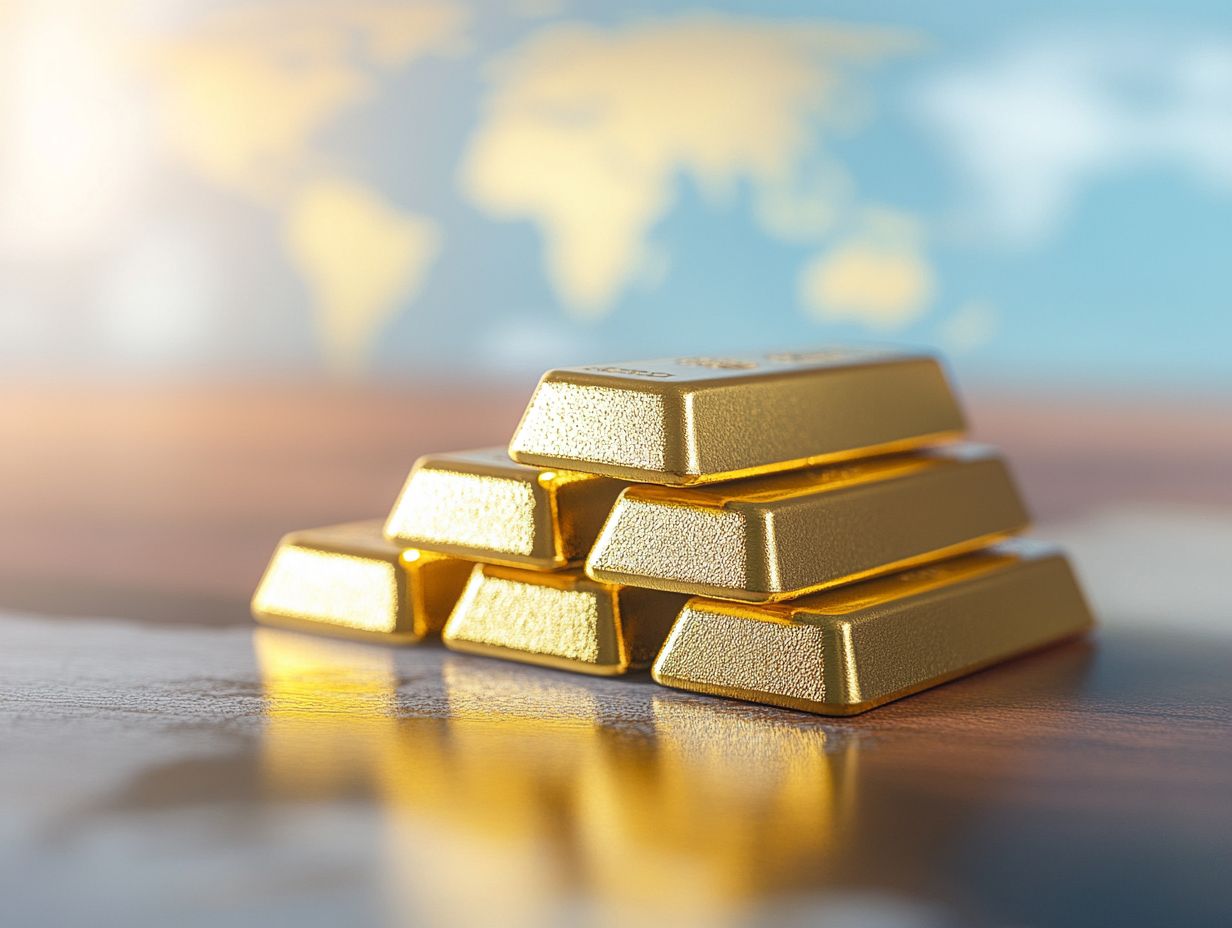
What is the role of gold in the global economy?
Gold plays a significant role in the global economy as a store of value and a medium of exchange.
How does gold impact currency values?
Gold has a direct impact on currency values, as it serves as a benchmark for the value of currencies around the world.
What are the top five countries with the largest gold reserves?
The top five countries with the largest gold reserves are the United States, Germany, Italy, France, and China.
How does gold affect international trade?
Gold affects international trade by serving as a means of payment for goods and services, as well as influencing trade balances and currency values.
Why is gold seen as a safe place for money?
Gold has long been a trusted safety net for investors! It’s something people turn to when they fear economic turmoil.
How does the price of gold impact the global economy?
The price of gold significantly impacts the global economy. It influences inflation, interest rates, and how much people spend. Understanding these effects is crucial, especially during times of economic change.










